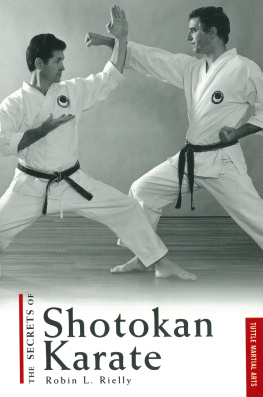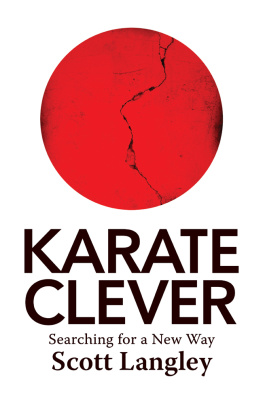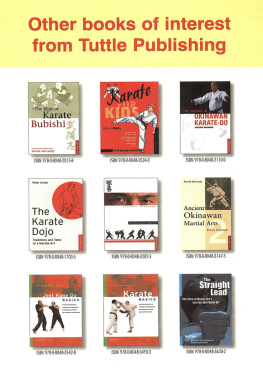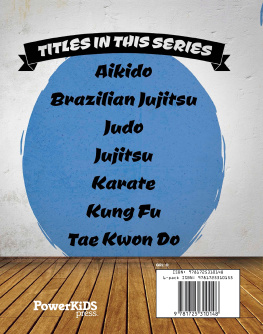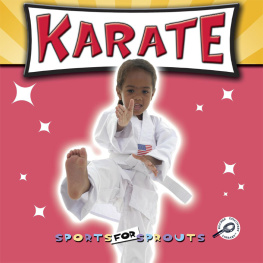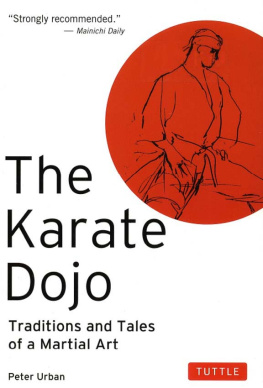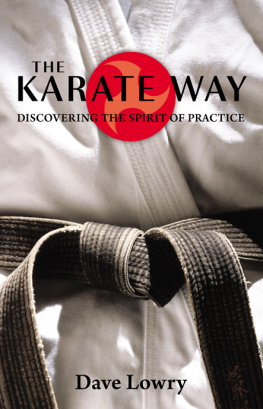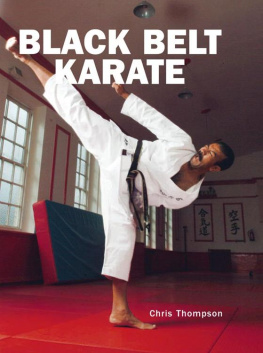C.W. Nicol - Moving Zen: Karate as a Way to Gentleness
Here you can read online C.W. Nicol - Moving Zen: Karate as a Way to Gentleness full text of the book (entire story) in english for free. Download pdf and epub, get meaning, cover and reviews about this ebook. year: 2013, publisher: C.W. Nicol, genre: Non-fiction. Description of the work, (preface) as well as reviews are available. Best literature library LitArk.com created for fans of good reading and offers a wide selection of genres:
Romance novel
Science fiction
Adventure
Detective
Science
History
Home and family
Prose
Art
Politics
Computer
Non-fiction
Religion
Business
Children
Humor
Choose a favorite category and find really read worthwhile books. Enjoy immersion in the world of imagination, feel the emotions of the characters or learn something new for yourself, make an fascinating discovery.
- Book:Moving Zen: Karate as a Way to Gentleness
- Author:
- Publisher:C.W. Nicol
- Genre:
- Year:2013
- Rating:4 / 5
- Favourites:Add to favourites
- Your mark:
- 80
- 1
- 2
- 3
- 4
- 5
Moving Zen: Karate as a Way to Gentleness: summary, description and annotation
We offer to read an annotation, description, summary or preface (depends on what the author of the book "Moving Zen: Karate as a Way to Gentleness" wrote himself). If you haven't found the necessary information about the book — write in the comments, we will try to find it.
Moving Zen: Karate as a Way to Gentleness — read online for free the complete book (whole text) full work
Below is the text of the book, divided by pages. System saving the place of the last page read, allows you to conveniently read the book "Moving Zen: Karate as a Way to Gentleness" online for free, without having to search again every time where you left off. Put a bookmark, and you can go to the page where you finished reading at any time.
Font size:
Interval:
Bookmark:
Moving Zen: Karate as a Way to Gentleness
C.W. Nicol
Illustrations by: Munehiro Ikeda
Copyright 2016 C.W. Nicol
All rights reserved
Table of Contents
Born in Wales, leaving for the first of fifteen researchexpeditions to the arctic at the age of seventeen, C.W. Nicol now lives inKurohime, in the Japan Alps, where he has established a woodland trust The C.W. Nicol Afan Woodland Trust. He gained Japanese citizenship in 1995. Hewas the first Game Warden of the Simien Mountain National Park in Ethiopia, hassailed as an observer with the Japanese whaling fleet to the Antarctic, and washonoured with an MBE by the British Queen. He has published over one hundredand twenty-six books, including novels, non-fiction work, children's books andessays and has also presented and directed a great many documentaries forJapanese television. He has written and published novels in both English andJapanese.
Follow C.W. Nicol on Facebook and YouTube:
https://www.facebook.com/oldnicspage
https://www.youtube.com/OldNicsChannel
C.W. Nicol Amazon Author Page
http://amazon.com/author/c.w.nicol
The C.W. Nicol Afan Woodland Trust
http://www.afan.or.jp
Available onKindle by C.W. Nicol:
THE WHITE HIPPO
WHALER, WHALER
GRIFFIN AND THE RIVERFOLK
ISANA
THE ALLIANCE
WHEN TWO STRONG MEN
AFAN STORY
THE NAKED PRINCE
THE WHITE SHAMAN
FROM THE ROOF OFAFRICA
Moving Zen was first publishedin 1975. Apparently it still sells, but I havent received any royalties fromthe book in over seventeen years, so with help from friends, I have decided topublish again in a digital form as well as print-on-demand. I was twenty-twoyears old when I first came to Japan and started to practise Karate.
As I write this now I am comingup to my seventy-fifth birthday. My home is in northern Nagano, Japan. Ahundred yards from my house I built a study and library, below which is alittle bar and a larger dojo. (Got to have balance, right?)
A beautiful mountain river, the Torii or Sacred Gatewayflows past this building, and beyond is the magnificent dormant volcano nameKurohime or Black Princess. In legend the Black Princess is wedded to a BlackDragon. The mountain is just over two thousand metres high, but is forested tothe top. Its a great place to live.
A leisurely half hour walk frommy house will take me to a woodland that I and my staff have been nurturingsince 1986. I donated the land I had bought and used up all my savings toestablish a woodland trust in 2002. This woodland is very beautiful and is ahome or a regular place to visit for bears, wild boar, deer, foxes, badgers,racoon dogs, civet cats, martens, weasels, squirrels, flying squirrels, hares,moles, voles, wood mice and dormice. Many famous people, including PrinceCharles and members of Japans Imperial Family have visited us.
In flora and fauna we have catalogued fifty-two endangeredspecies in our woods, and in 2002 it was declared as a Heritage for the Futureby UNESCO Japan.
What has this to do with MovingZen?
When I was training to get myfirst black belt in the old dojo in Yotsuya, I told Kanazawa Sensei that Iwould promise to practice Karate when I left Japan, but that my career would bewith wildlife, and not as a professional Karate teacher. Many of the westernerstraining at the dojo at that time did become professional Karate teachers whenthey returned home, and indeed, several of them became superb Karateka andfamous teachers. I just helped out teaching Karate classes at McGill Universityand Manitoba University in between field trips to the Canadian arctic. I havenever taken any money for that.
Now in my seventies, with stiffknees (hey guys, forget those rabbit hops OK?) and thick in the waist I stilldodder around in my dojo when I can, although my schedule with making lecturesand documentaries all over Japan and my work in restoring woodland takes up agreat deal of time. However, Karate is, and always has been the way, the core,the balance in my life. Stan Schmitt once said to me that Karate should notbe translated as empty hand but rather as open hand. That is exactly right.For me Karatedo, the way of the open hand has given me courage in the face ofdanger and in some very nasty situations, and although the art has saved mylife on a few occasions, it has certainly kept me out of more fights than itever got me into. Moreover, through Karate I have gained far more friends thanenemies.
Munehiro Ikeda, who did theoriginal illustrations, lives a short drive away, is still a close friend, andis now a famous sculptor and a 9th. dan in traditional swordsmanship. KanazawaHirokazu, to whom this book was first dedicated, still is and always will be mySensei, but he is also a dear and respected friend, and one of the greatestKarate teachers in history.
In 1995 I became a Japanesecitizen. Three of my grownup children and five of my grandchildren all live inVancouver, and my oldest daughter Miwako practises Karate whenever she canescape from raising twin daughters. The way of the open hand and open heartbegan for me in Japan, and will end in Japan. All in all Im a happy man, andhave lived a full and exciting life. Mind you, I have a lot more to do before Iget called to that last great and mysterious dojo.
Be both strong and gentle in your art. There is no realcourage without compassion. Be bold, do your best, but remember, rank andchampionships are fine, but it is the path, the way, that is of mostimportance.
C.W. Nicol
Kurohime, Nagano, Japan.
April 2013
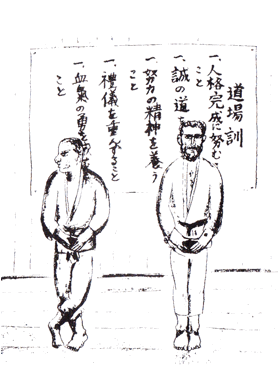
The Japanese character sen means aheador before. The character sei has the essence of many meanings life, birth, pure, genuine,raw. If the two characters are put together, they form the word sensei, whichis poorly translated as teacher, and yet is the title given to teachers andto those people who demand great respect.
Mr. Takagi, or rather, Takagisensei, was the director of the Japan Karate Association, which, in the earlysixties, was the largest Karate organization in Japan. It was recognized by theMinistry of Education; its goal to improve and create wider interest in Karate.At first glance, Takagi sensei was not an imposing figure. He was shortish,round-faced, with the air of an affable, good-natured businessman. Yet his eyescarried the steel of the Karateka, the practitioner of Karate, and he held thefifth degree, or dan grade of black belt.
This was Tokyo, and I had comehere, in the late fall of 1962 to devote myself to the study of martial arts,and in particular to the study of Karate, one of the deadliest systems ofunarmed fighting in the world. But there are many paths to take, many styles tofollow, and Takagi sensei had said at our first meeting, There are otherschools. Go to them and see, and then come back if you have truly decided toenter our school.
And so I went from place to placein Tokyo, visiting the dojo, or practice hall, of each of the main schools orstyles of Karate. In Japan, Karate is followed as a religion is followed. Thestudent can follow only one way, he cannot switch and change, or be fickle withhis loyalties. It is not the Karate way.
I saw the Wado style. Itspractitioners had movements that were graceful and flowing, and there I sawKarateka pitted against swordsman in a ritual ballet, and marveled at the linesof the body curving and leaping in and out of the range of the slicing steel,like a mongoose -feinting at a cobra.
I saw the Goju style. It waspowerful and menacing, and its followers developed iron-hard bodies throughtheir special breathing exercises, and by dynamic tension and relaxation,moving in the dojo like angered tigers crouching in the bamboo, breath hissingand rasping through nostrils and throats, now moving slowly, slowly, and thenwith incredible swiftness. The school was dominated by the Master Yamaguchi,whom they call The Cat. He wore his hair down to his shoulders, and was neverseen in Western dress, preferring the somber dignity of kimono and the wide,skirt-like hakama, traditional male dress of Japan.
Next pageFont size:
Interval:
Bookmark:
Similar books «Moving Zen: Karate as a Way to Gentleness»
Look at similar books to Moving Zen: Karate as a Way to Gentleness. We have selected literature similar in name and meaning in the hope of providing readers with more options to find new, interesting, not yet read works.
Discussion, reviews of the book Moving Zen: Karate as a Way to Gentleness and just readers' own opinions. Leave your comments, write what you think about the work, its meaning or the main characters. Specify what exactly you liked and what you didn't like, and why you think so.



